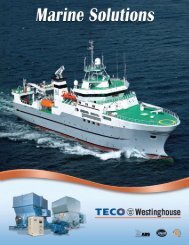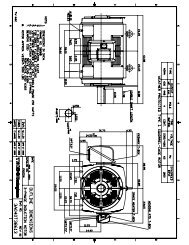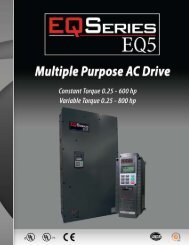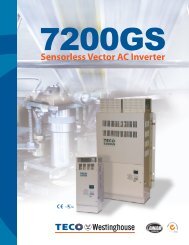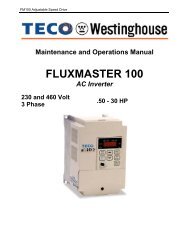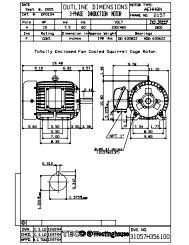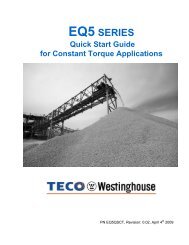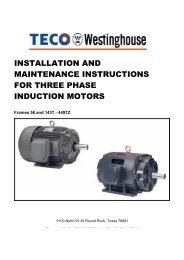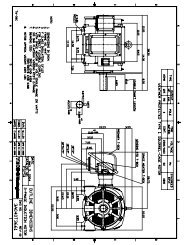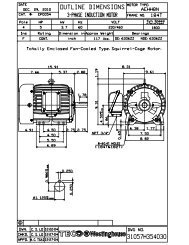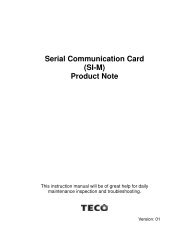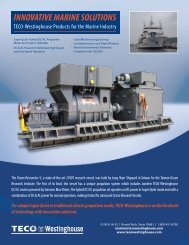EQ7 Series Instruction Manual - TECO-Westinghouse Motor Company
EQ7 Series Instruction Manual - TECO-Westinghouse Motor Company
EQ7 Series Instruction Manual - TECO-Westinghouse Motor Company
Create successful ePaper yourself
Turn your PDF publications into a flip-book with our unique Google optimized e-Paper software.
• Auto torque boost (F37 = 2, 5)<br />
If the auto torque boost is selected, the inverter automatically optimizes the output voltage to fit the motor with its<br />
load. Under light load, the inverter decreases the output voltage to prevent the motor from over-excitation. Under<br />
heavy load, it increases the output voltage to increase the output torque of the motor.<br />
• Since this function relies also on the characteristics of the motor, set the base frequency 1 (F04), the<br />
rated voltage at base frequency 1 (F05), and other pertinent motor parameters (P01 through P03 and<br />
P06 through P99) in line with the motor capacity and characteristics, or else perform auto-tuning (P04).<br />
• When a special motor is driven or the load does not have sufficient rigidity, the maximum torque might<br />
decrease or the motor operation might become unstable. In such cases, do not use auto torque boost<br />
instead choose manual torque boost per F09 (F37 = 0 or 1).<br />
• Auto energy saving operation (H67)<br />
If the auto energy saving operation is enabled, the inverter automatically controls the supply voltage to the motor<br />
to minimize the total power loss of motor and inverter. (Note that this feature may not be effective depending upon<br />
the motor or load characteristics. Check the advantage of energy saving before you actually apply this feature to<br />
your machinery.)<br />
Select whether applying this feature to constant speed operation only or applying to constant speed operation and<br />
accelerating/decelerating operation.<br />
Data for H67<br />
Auto energy saving operation<br />
0 Enable only during running at constant speed<br />
Enable during running at constant speed or accelerating/decelerating<br />
1<br />
(Note: For accelerating/decelerating, enable only when the load is light.)<br />
If auto energy saving operation is enabled, the response to a motor speed changes from constant speed operation<br />
may be slow. Do not use this feature for machinery that requires quick acceleration/deceleration.<br />
• Use auto energy saving only where the base frequency is 60 Hz or lower. If the base frequency is set at<br />
60 Hz or higher, little or no energy saving advantage may result. The auto energy saving operation is<br />
designed for use with the frequency lower than the base frequency. If the frequency becomes higher than<br />
the base frequency, the auto energy saving operation will be invalid.<br />
• Since this function relies also on the characteristics of the motor, set the base frequency 1 (F04), the<br />
rated voltage at base frequency 1 (F05), and other pertinent motor parameters (P01 through P03 and<br />
P06 through P99) in line with the motor capacity and characteristics, or else perform auto-tuning (P04).<br />
• Under the vector control without speed sensor, the auto energy saving operation is disabled.<br />
F38, F39 Stop frequency (Detection mode, Holding time) (Refer to F23.) see page 4-51<br />
F40, F41 Torque Limiter 1-1, E16, E17 Torque Limiter 2-1, Torque Limiter 2-2<br />
Torque Limiter 1-2<br />
H73 Torque Limiter (Operating conditions)<br />
H76 Torque Limiter (Frequency increment limit for braking)<br />
Under V/f control<br />
If the inverter’s output torque exceeds the specified levels of the torque limiters (F40, F41, E16, E17, and E61 to<br />
E63), the inverter controls the output frequency and limits the output torque to prevent a stall.<br />
To use the torque limiters, it is necessary to configure the function codes listed in the table on the next page.<br />
In braking, the inverter increases the output frequency to limit the output torque. Depending on the<br />
conditions during operation, the output frequency could be excessive. H76 (Frequency increment limit for<br />
braking) is provided to limit the increasing frequency component.<br />
4-58



